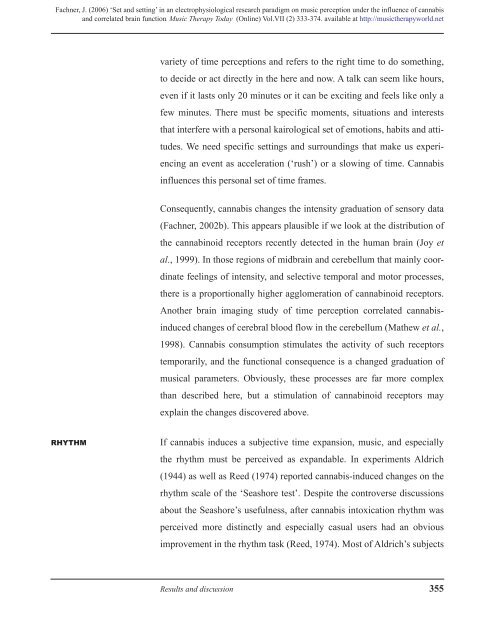Music Therapy Today - World Federation of Music Therapy
Music Therapy Today - World Federation of Music Therapy
Music Therapy Today - World Federation of Music Therapy
Create successful ePaper yourself
Turn your PDF publications into a flip-book with our unique Google optimized e-Paper software.
Fachner, J. (2006) ‘Set and setting’ in an electrophysiological research paradigm on music perception under the influence <strong>of</strong> cannabis<br />
and correlated brain function. <strong>Music</strong> <strong>Therapy</strong> <strong>Today</strong> (Online) Vol.VII (2) 333-374. available at http://musictherapyworld.net<br />
variety <strong>of</strong> time perceptions and refers to the right time to do something,<br />
to decide or act directly in the here and now. A talk can seem like hours,<br />
even if it lasts only 20 minutes or it can be exciting and feels like only a<br />
few minutes. There must be specific moments, situations and interests<br />
that interfere with a personal kairological set <strong>of</strong> emotions, habits and atti-<br />
tudes. We need specific settings and surroundings that make us experi-<br />
encing an event as acceleration (‘rush’) or a slowing <strong>of</strong> time. Cannabis<br />
influences this personal set <strong>of</strong> time frames.<br />
Consequently, cannabis changes the intensity graduation <strong>of</strong> sensory data<br />
(Fachner, 2002b). This appears plausible if we look at the distribution <strong>of</strong><br />
the cannabinoid receptors recently detected in the human brain (Joy et<br />
al., 1999). In those regions <strong>of</strong> midbrain and cerebellum that mainly coor-<br />
dinate feelings <strong>of</strong> intensity, and selective temporal and motor processes,<br />
there is a proportionally higher agglomeration <strong>of</strong> cannabinoid receptors.<br />
Another brain imaging study <strong>of</strong> time perception correlated cannabis-<br />
induced changes <strong>of</strong> cerebral blood flow in the cerebellum (Mathew et al.,<br />
1998). Cannabis consumption stimulates the activity <strong>of</strong> such receptors<br />
temporarily, and the functional consequence is a changed graduation <strong>of</strong><br />
musical parameters. Obviously, these processes are far more complex<br />
than described here, but a stimulation <strong>of</strong> cannabinoid receptors may<br />
explain the changes discovered above.<br />
RHYTHM If cannabis induces a subjective time expansion, music, and especially<br />
the rhythm must be perceived as expandable. In experiments Aldrich<br />
(1944) as well as Reed (1974) reported cannabis-induced changes on the<br />
rhythm scale <strong>of</strong> the ‘Seashore test’. Despite the controverse discussions<br />
about the Seashore’s usefulness, after cannabis intoxication rhythm was<br />
perceived more distinctly and especially casual users had an obvious<br />
improvement in the rhythm task (Reed, 1974). Most <strong>of</strong> Aldrich’s subjects<br />
Results and discussion 355

















